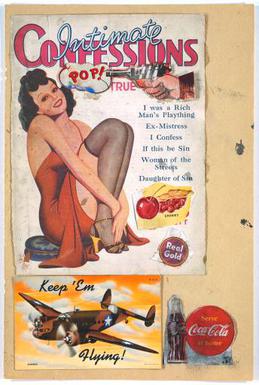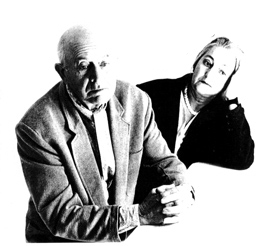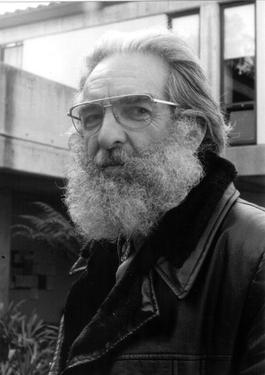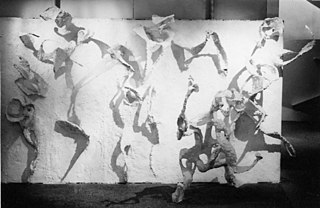Related Research Articles

Pop art is an art movement that emerged in the United Kingdom and the United States during the mid- to late-1950s. The movement presented a challenge to traditions of fine art by including imagery from popular and mass culture, such as advertising, comic books and mundane mass-produced objects. One of its aims is to use images of popular culture in art, emphasizing the banal or kitschy elements of any culture, most often through the use of irony. It is also associated with the artists' use of mechanical means of reproduction or rendering techniques. In pop art, material is sometimes visually removed from its known context, isolated, or combined with unrelated material.

Alison Margaret Smithson and Peter Denham Smithson were English architects who together formed an architectural partnership, and are often associated with the New Brutalism, especially in architectural and urban theory.
Brutalist architecture is an architectural style that emerged during the 1950s in the United Kingdom, among the reconstruction projects of the post-war era. Brutalist buildings are characterised by minimalist constructions that showcase the bare building materials and structural elements over decorative design. The style commonly makes use of exposed, unpainted concrete or brick, angular geometric shapes and a predominantly monochrome colour palette; other materials, such as steel, timber, and glass, are also featured.

The Institute of Contemporary Arts (ICA) is an artistic and cultural centre on The Mall in London, just off Trafalgar Square. Located within Nash House, part of Carlton House Terrace, near the Duke of York Steps and Admiralty Arch, the ICA contains galleries, a theatre, two cinemas, a bookshop and a bar. Bengi Unsal became the director in 2022.

Richard William Hamilton CH was an English painter and collage artist. His 1955 exhibition Man, Machine and Motion and his 1956 collage Just what is it that makes today's homes so different, so appealing?, produced for the This Is Tomorrow exhibition of the Independent Group in London, are considered by critics and historians to be among the earliest works of pop art. A major retrospective of his work was at Tate Modern until May 2014.

Sir Eduardo Luigi Paolozzi was a Scottish artist, known for his sculpture and graphic works. He is widely considered to be one of the pioneers of pop art.

Ithell Colquhoun was a British painter, occultist, poet and author. Stylistically her artwork was affiliated with surrealism. In the late 1930s, Colquhoun was part of the British Surrealist Group before being expelled because she refused to renounce her association with occult groups.

Peter Reyner Banham Hon. FRIBA was an English architectural critic and writer best known for his theoretical treatise Theory and Design in the First Machine Age (1960) and for his 1971 book Los Angeles: The Architecture of Four Ecologies. In the latter he categorized the Los Angeles experience into four ecological models and explored the distinct architectural cultures of each. A frequent visitor to the United States from the early 1960s, he relocated there in 1976.
Lawrence Reginald Alloway was an English art critic and curator who worked in the United States from 1961. In the 1950s, he was a leading member of the Independent Group in the UK and in the 1960s was an influential writer and curator in the US. He first used the term "mass popular art" in the mid-1950s and used the term "Pop Art" in the 1960s to indicate that art has a basis in the popular culture of its day and takes from it a faith in the power of images. From 1954 until his death in 1990, he was married to the painter Sylvia Sleigh.
Emma Frith Bridgwater, known as Emmy Bridgwater, was an English artist and poet associated with the Surrealist movement.

This Is Tomorrow was an art exhibition in August 1956 at the Whitechapel Art Gallery on Whitechapel High Street in London's East End, UK, facilitated by curator Bryan Robertson. The core of the exhibition was the ICA Independent Group.
John McHale was a British artist, art theorist, sociologist and future studies searcher. He was a member of the Independent Group, a British movement that originated pop art which grew out of an interest in American mass culture and post–World War II technologies.
Frank Cordell was a British composer, arranger and conductor, who was active with the Institute of Contemporary Arts. He also composed music under the name Frank Meilleur or Meillear.
Antonino Romanov del Renzio dei Rossi di Castellone e Venosa , an artist and writer of Italian and Russian parentage, was leader of the British Surrealist Group for a period.

John Harold Westgarth Voelcker was an English architect. A member of the Team 10 group of architects, he ran a small rural practice before his appointment first Professor of Architecture at the University of Glasgow.

Magda Cordell McHale was a Hungarian artist, futurist, and educator. She was a founding member of the Independent Group which was a British movement that originated Pop Art which grew out of a fascination with American mass culture and post-WWII technologies. Later, she was a faculty member in the University at Buffalo School of Architecture & Planning.

Theo Crosby was an architect, editor, writer and sculptor, engaged with major developments in design across four decades. He was also an early vocal critic of modern urbanism. He is best remembered as a founding partner of the international design partnership Pentagram, and as architect for the reconstruction of Shakespeare's Globe in London. However, his role as éminence grise in British architecture and design from 1950 to 1990 helped effect much broader changes. Crosby's archive is located at the University of Brighton Design Archives.
ArtReview is an international contemporary art magazine based in London, founded in 1948. Its sister publication, ArtReview Asia, was established in 2013.

William Turnbull was a Scottish artist.

I was a Rich Man's Plaything is a 1947 artwork by Eduardo Paolozzi. The collage was made from cuttings from American magazines and advertisements, mounted on card. The work of juxtaposed found objects is considered a seminal piece of pop art: it was the first to include the word "pop" in its design, years before Lawrence Alloway coined the term "pop art".
References
- 1 2 3 Livingstone, M., (1990), Pop Art: A Continuing History, New York: Harry N. Abrams, Inc.
- ↑ Arnason, H., History of Modern Art: Painting, Sculpture, Architecture, New York: Harry N. Abrams, Inc. 1968.
- ↑ Melly, George. Revolt into Style. Pop Arts in Britain, London, A. Lane, 1970.
- ↑ ″Enduardo Paolozzi″, Exhibit Catalog, Hefte der Akademie der Bildenden Künste, 1977.
- ↑ Tate Collection image: I was a Rich Man's Plaything